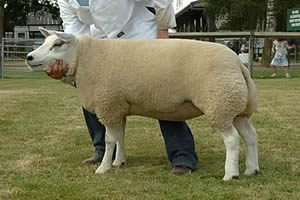|
25/07/06
English sheep producers should safeguard next year’s flock
productivity by conducting a simple MOT on all their breeding
rams in the coming few weeks, advises the English Beef and Lamb
Executive (EBLEX).
A thorough check-over at least 8 weeks before tupping will identify
over 90% of the problems that reduce ram performance. This gives
sufficient time for body condition and health to be improved wherever
necessary. It also enables new rams to be sourced, quarantined
and acclimatised to the farm in time to replace any that prove
beyond repair. All of which allows flock managers to ensure all
tups go into the breeding season fully fit and fertile.
As well as ensuring the best overall flock fertility and compact lambing, good
ram preparation improves profitability by increasing the average productive life
of each tup, reducing the ram cost per ewe served. Indeed, extending the working
life of a ram from three to four years is calculated to cut this cost by nearly
60p/ewe.
EBLEX suggests focusing on the four Ts in particular, in the ram
MOT – Teeth, Toes, Testicles and Tone. Producers should
take into account overall health and condition when considering
culling or possibly retaining a ram for one more season as a back
up.
- Teeth – Rams that have lost teeth or
with teeth that have become long or thin may not be able to put
on sufficient body condition ahead of tupping and maintain it
sufficiently well during the breeding season to sustain their
performance.
- Toes – Lameness seriously affects a
ram’s working ability, and foot rot and other infections
reduce fertility through raised body temperatures. Feet should
be trimmed wherever necessary, foot-bathing employed to prevent
or treat infections, and footrot treated with injectable antibiotics.
- Testicles – Large, firm testicles produce
80% more semen per day than medium-sized soft ones. The testes
and scrotum should be free from hard lumps, ulcers, injuries,
lesions or parasites. And the penis sheath should be clear of
infection with no sign of shearing damage. Infections and physical
damage need to be treated. Rams with clear defects should be
culled.
- Tone – Rams need to be in good body
condition (Body Condition Score 3.5 – 4.0) at the start
of tupping as they can lose 15% of their bodyweight during a
six week breeding season and poor condition can seriously affect
both performance and fertility. They should be feed up to 1kg/day
of a high quality 18-20% protein ration without added magnesium
but supplemented with other trace elements and vitamins where
necessary for 6-8 weeks before tupping to improve condition and
semen quality.
Detailed guidance on preparing ewes as well as rams for tupping
is provided in Sheep Better Returns Programme Manual 4: Target
Ewe Management for Better Returns available free to English producers
from EBLEX on 0870 241 8829 or www.eblex.org.uk.
 EU Sheep Tagging Derogation Secured EU Sheep Tagging Derogation Secured
 Lambs Benefit From New Natural
Plant Additive Lambs Benefit From New Natural
Plant Additive
 New Suffolk Sheep recording scheme launched New Suffolk Sheep recording scheme launched
|



